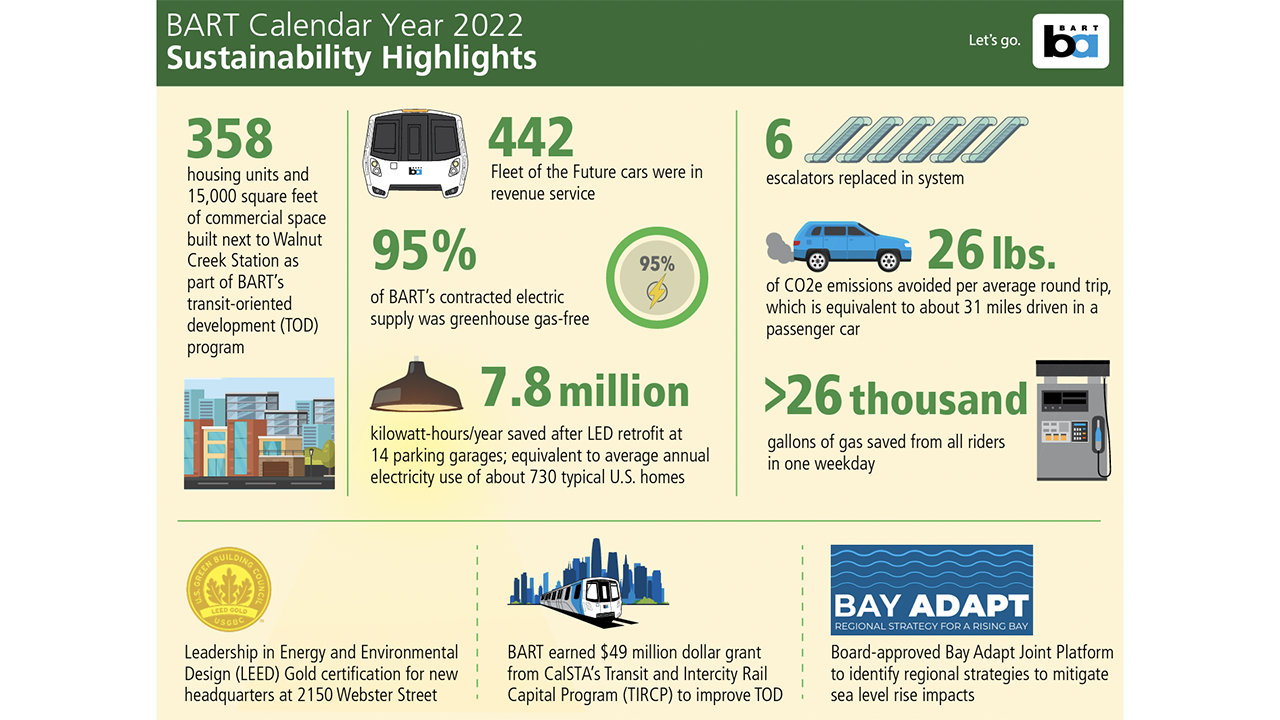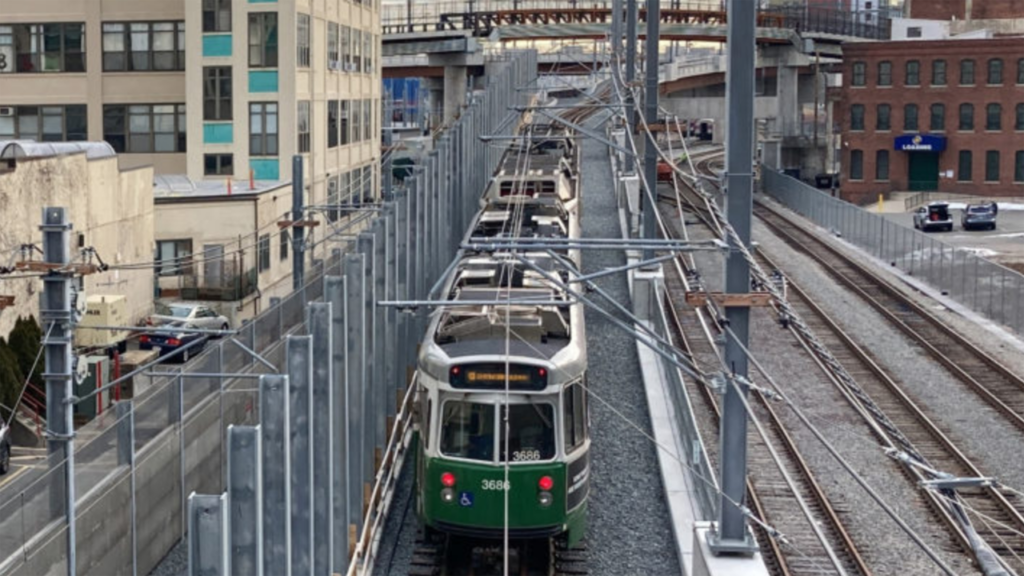
Transit Briefs: BART, MBTA
Written by Marybeth Luczak, Executive Editor
BART on July 26 released its annual Sustainability Report.
San Francisco Bay Area Rapid Transit District (BART) releases its 2022 Sustainability Report. Also, Massachusetts lawmakers propose transferring Massachusetts Bay Transportation Authority (MBTA) safety oversight to a new independent agency.
BART on July 27 issued a 2022 Sustainability Report (above), addressing its five decades of sustainability efforts. “From its inception in the 1950s, BART’s founders prioritized central locations in the Bay Area to provide convenient service within walking distance,” the transit agency reported. “[T]heir forward thinking has enabled BART’s Transit-Oriented Development program to build housing and commercial spaces next to transit hubs. From the onset, BART was designed to run electric trains, which produce no emissions or pollution at point of use. Since 2020, core BART trains are powered by 100% greenhouse gas-free sources from a diverse mix of hydroelectric, wind and solar generation.”
BART in 2022 recorded its “lowest total energy use and potable water use since it began tracking these metrics in 2015,” the transit agency reported. “BART’s total greenhouse gas emissions dropped 92% in 2022 compared to 2015, meaning it has already achieved its 2025 target goals.”
In the report, BART highlights its progress in modernization of infrastructure and equipment, including trains, stations and parking garages. Modernization projects were completed at 19th Street and Powell Street stations, for example, improving the rider experience and saving energy by using LED lighting and new underground restrooms with water-efficient fixtures, according to the transit agency. Additionally, BART’s new lighting at the two stations conserves more than 510,000 kWh annually, which the agency said is “equivalent to the annual electricity usage of about 48 homes in the United States.” BART also upgraded more than 10,500 lighting fixtures across 14 parking garages, switching from dated metal halide and sodium-vapor fixtures to brighter and more energy-efficient LED lights, which require less maintenance. “In addition to making park-and-ride BART patrons feel safer, this project is estimated to save nearly 7.8 million kWH each year, or equivalent to the annual electricity use of 730 U.S. homes,” according to BART.
BART said that in 2022 it took two major steps to advance its climate resiliency. The first was updating its Local Hazard Mitigation Plan, a planning document that identifies the risks of natural hazards (flooding, rising sea levels, extreme heat, and wildfires, among others), and actions for reducing such risks. Actions include seismic retrofits, slope stabilization and erosion control, and fire protection replacement. The second step was endorsing the Bay Adapt Joint Platform, described as “a regional strategy addressing how the Bay Area will adapt to rising sea levels.” The BART Board of Directors joined 55 other Bay Area cities, counties and organizations in support of regional adaptation to sea level rise, the transit agency said.
Finally, BART, in recognition of its “constant interaction with the wildlife” surrounding stations, hired a falconer to mitigate pigeons and has long contracted a local beekeeper to remove beehives found on the system. During the summer months, BART also uses goats (and sheep this year) to graze on dry vegetation across the hills and fields next to BART right-of-ways to reduce wildfire risk.

A new independent agency, rather than the Department of Public Utilities, would handle MBTA safety oversight under a bill filed by the Massachusetts Joint Committee on Transportation, according to a July 26 Boston Herald report.
“Oversight of the ferry system, buses, regional transit authorities and the commuter rail would fall under this new ‘Office of Transit Safety,’ State Rep. William Straus, co-chair of the Transportation Committee, said,” according to the newspaper.
The Boston Herald reported that the Office’s Executive Director “would be appointed by a model that was copied from the Office of the Inspector General, which notably, rejected a suggestion that safety oversight of the MBTA be placed there in early May.”
“Three constitutional officers, the governor, attorney general and secretary of state, would appoint an executive director for the transit safety office by majority vote,” and that director would have a three-year term, reported the newspaper.
“Straus described the proposed legislation as a ‘strong recommendation’ from the Joint Committee on Transportation, based on a series of oversight hearings that examined deficiencies at the MBTA and DPU,” according to the Herald.
“The hearings began amid a rare federal probe into the MBTA’s subway system. Out of that investigation came a critical report from the Federal Transit Administration, which cited concerns with the DPU’s ineffective safety oversight and lack of independence from the governor’s office.
“Safety failures continued during, and after, the months-long investigation, which was prompted by a fatality that occurred on the Red Line.”
According to the Boston Herald, the Federal Transit Administration would still have to certify the oversight model if the bill is approved by the legislature and signed by the Governor.



